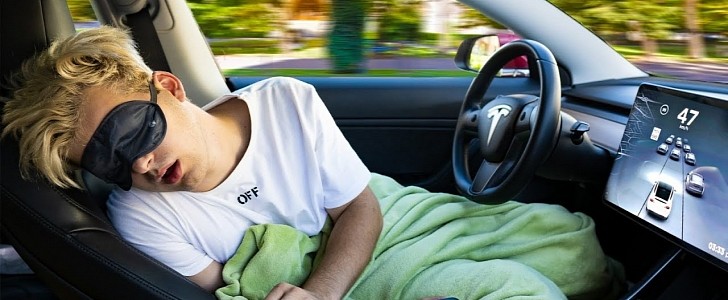After Elon Musk’s Tesla decided to bet big on self-driving features that are being tested by paying customers on public roads, other American and European automakers decided to follow. Now almost everyone’s trying to offer as many advanced driver-assistance features or systems as possible. The sad thing is, however, that most companies are doing it to charge the consumer more. This survey sheds some light on how people from the U.S. relate to this trend.
Just a little over a decade ago, driver-assistance systems were being democratized. They were being installed on cheaper cars and were offered mostly to help drivers navigate boring parts of the roads like highways with speed limits. But things are changing, and the basic lane-keeping assist system or the traffic-sign recognition one is being replaced by a suite of advanced driver-assistance systems (ADAS) which could one day enable real self-driving.
Autonomous cars do not exist yet. Tesla’s Full Self-Driving Beta (or Autopilot for highways), Ford’s BlueCruise, or the Mercedes-Benz Drive Pilot are not Level 5 automation systems. The driver is required to remain focused and ready to take over. Even Waymo’s driverless taxis can be wirelessly controlled by humans in case their systems fail. We’re not there – yet.
But with the development of numerous ADAS and a race between major carmakers to prove they’re the best in this department, some (if not most) consumers have been left behind. The majority of those who enjoy testing out these technologies are also interested in other software-related things or have some knowledge about the digital era. Other drivers, however, might feel left out. Some might even consider this progress useless because they might like driving themselves all the time.
A Policygenius survey conducted on a sample of 1,500 adults from the U.S. that are 18 or older revealed that 76% of those asked would feel less safe driving or riding in a car with self-driving features. Similarly, Americans don’t like the thought of knowing autonomous cars are on public roads – 73% said they’d feel less safe.
Since the company that paid for the survey is also an insurance provider, it asked those surveyed if owners of cars with self-driving features should pay more. The majority (62%) answered yes.
Americans would also not pay more for self-driving features – 79% said no. Some carmakers increased the prices for their ADAS systems, while others explore subscription-based plans. Maybe that's not such a great idea, after all.
But there’s some confusion as well. People questioned about who should be held responsible in case a car with active self-driving features causes a crash are divided on the matter equally – 50% would blame the human behind the wheel, while the other half would hold the automaker accountable. In reality, the driver is always responsible. There are some small exceptions. But to exonerate the driver, an investigation that proves the system is solely at fault must happen.
Carmakers have a lot more work to do if they want to gain Americans' trust in self-driving cars.
Autonomous cars do not exist yet. Tesla’s Full Self-Driving Beta (or Autopilot for highways), Ford’s BlueCruise, or the Mercedes-Benz Drive Pilot are not Level 5 automation systems. The driver is required to remain focused and ready to take over. Even Waymo’s driverless taxis can be wirelessly controlled by humans in case their systems fail. We’re not there – yet.
But with the development of numerous ADAS and a race between major carmakers to prove they’re the best in this department, some (if not most) consumers have been left behind. The majority of those who enjoy testing out these technologies are also interested in other software-related things or have some knowledge about the digital era. Other drivers, however, might feel left out. Some might even consider this progress useless because they might like driving themselves all the time.
A Policygenius survey conducted on a sample of 1,500 adults from the U.S. that are 18 or older revealed that 76% of those asked would feel less safe driving or riding in a car with self-driving features. Similarly, Americans don’t like the thought of knowing autonomous cars are on public roads – 73% said they’d feel less safe.
Since the company that paid for the survey is also an insurance provider, it asked those surveyed if owners of cars with self-driving features should pay more. The majority (62%) answered yes.
Americans would also not pay more for self-driving features – 79% said no. Some carmakers increased the prices for their ADAS systems, while others explore subscription-based plans. Maybe that's not such a great idea, after all.
But there’s some confusion as well. People questioned about who should be held responsible in case a car with active self-driving features causes a crash are divided on the matter equally – 50% would blame the human behind the wheel, while the other half would hold the automaker accountable. In reality, the driver is always responsible. There are some small exceptions. But to exonerate the driver, an investigation that proves the system is solely at fault must happen.
Carmakers have a lot more work to do if they want to gain Americans' trust in self-driving cars.






